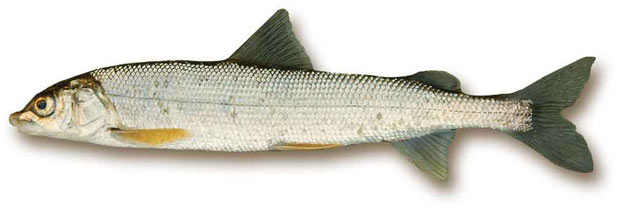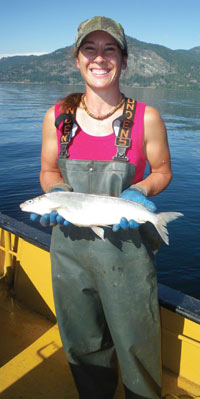Lake whitefish in Pend Oreille
Most abundant, most alien, most likely for a comeback
By Kate Wilson

The large and often ominous ear-shaped beauty that is Lake Pend Oreille is full of all kinds of critters and tales of old. One of the biggest mysteries that occupy the deep dark parts of Pend Oreille is a peculiar fish - one of the most numerous, but the least known, the lake whitefish (Coregonus clupeaformis).
Lake whitefish are not native in our narrow neck of the woods; they were introduced in 1898 for the sole purpose of producing a more accessible fishery for locals. Ironically, the lake whitefish fishery has never really taken off. There are two prominent lake whitefish anglers in the community, the last connection to a little-known legacy. These two, connected by a history of frosty first-light fishing, wish to see the species play a more significant role.
There are native whitefish in Pend Oreille, the mountain whitefish (Prosopium williamsoni); they occupy different depths and roles in the ecosystem as well as the community. From 1900 to 1937, there was a commercial fishery for these natives. It was quite successful for some time, with fresh fish shipped to nearly every state and nourishing families when they needed it most.
Sometimes anglers targeting perch or native whitefish would get lucky and catch a lake whitefish under the ice, but it was rare.
|
Historic photo of the SS Fish House |
"Lake whitefish were never successfully caught by the locals," says Bonner County Marine Deputy Rauno Ron Raiha, an avid whitefish angler. "Nobody ever really caught them on purpose; there are just a few of us."
Today, we know a bit more about the lake whitefish. There is a movement - albeit semi-small at this point - to recapture that original purpose of the introduced whitefish. Lake trout (Salvelinus namaycush) netting by Idaho Fish and Game has shown lake whitefish catches to outnumber lake trout 10-to-1; today more than 125,000 are estimated to live in Pend Oreille.
Bill Hawkins, a Sandpoint native, comes from a long tradition of whitefish angling. In the winter when work was scarce in the 1930s, Hawkins' uncle Bob Selle would walk across the Long Bridge to his rented cabin in Bottle Bay to fish.
 |
Avista fisheries technician Angie Hill, holds a lake whitefish, a bycatch on the predator netting boat. January and February are the best times for whitefishing, according to local anglers (photos courtesy Idaho Fish and Game, landscape photo by Andy Dux) |
"Uncle Bob would go out for a week at a time just to feed his family," said Hawkins. "Bob would make $5 a week if he caught his limit. It cost $2 for lodging - he could make $3 a week at best."
Raiha too, recalls old stories from the days of "five plank" boats.
"Nobody had any money then - the Humbird Mill workers would throw planks over the fence one at a time and come back for them at night," said Raiha.
These boats were comprised of 1-by-12 foot pine planks - three on the bottom and one on each side. They had no motors and homemade oars, a sign of the Great Depression days. These boats were also targeting the native whitefish, which congregate in much shallower waters than the lake whitefish.
The Northern Idaho News, in 1937, wrote about a Fish & Game commissioner responding to the "needs of Idaho people during strenuous times," being particularly interested in the mountain whitefish planting program at the Sandpoint Hatchery. The article asserts that the whitefish industry kept 200 families off relief rolls. Funny though, the hatchery boosted the native whitefish, while the lake whitefish, undeterred by anglers, took off on their own.
Today, nobody is counting on either kind of whitefish to keep their family from starving, but there is potential for some new blood and business in town. Just upstream in Flathead Lake, there is a large market for fresh whitefish eggs, dubbed "golden caviar." In Canada, more than a million pounds of whitefish are sold per year.
The best lake whitefish fishing is in January and February," said Hawkins. "Typically I like to hand-line at 60 to 100 feet deep with a double anchor line. In summer, a pole braided line works well - drift until you hit a school of whitefish. Drop the anchor and jig.
Raiha notes that the old kokanee fishing method - trolling near the bottom - works well on whitefish during the summer also.
"When I am hand-lining, they are so thick you can feel the sinker bouncing off those fish!" said Hawkins, with a reverence fortified by tradition. "That is the reason to hand-line. It is so much more sensitive than a pole."
Not only are these fish fun to catch, but they are tasty too. Light-fleshed and mild in flavor, whitefish are known for their excellent eating.
"Deep fried, baked whole, sautˇed with butter and rolled in flour. I've even made whitefish seviche," said Raiha, with a grin.
So how can we make a market for these fish? In 2007, graduate student Mike Hosack of the University of Wisconsin at Stevens Point studied the feasibility of establishing a commercial fishery for lake whitefish in Lake Pend Oreille.
Lake whitefish are an "ecologically and economically important freshwater fish throughout their range," wrote Hosack. "In 2005, commercial harvest of whitefish in the Great Lakes was 8.5 million pounds valued at over $6.8 million."
Hosack surmised that the whitefish in Pend Oreille are indeed a good candidate for a commercial fishery, so long as harvest is managed for sustainability; he estimated a limit of approximately 100,000 pounds annually.
The theory is that lake whitefish could sustain a viable commercial fishery, boost the local economy and assist current efforts to suppress lake trout, the major by-catch species. Hawkins is working to organize a perch and whitefish derby in February. Stay tuned: You just might find this fishery was meant for you. |